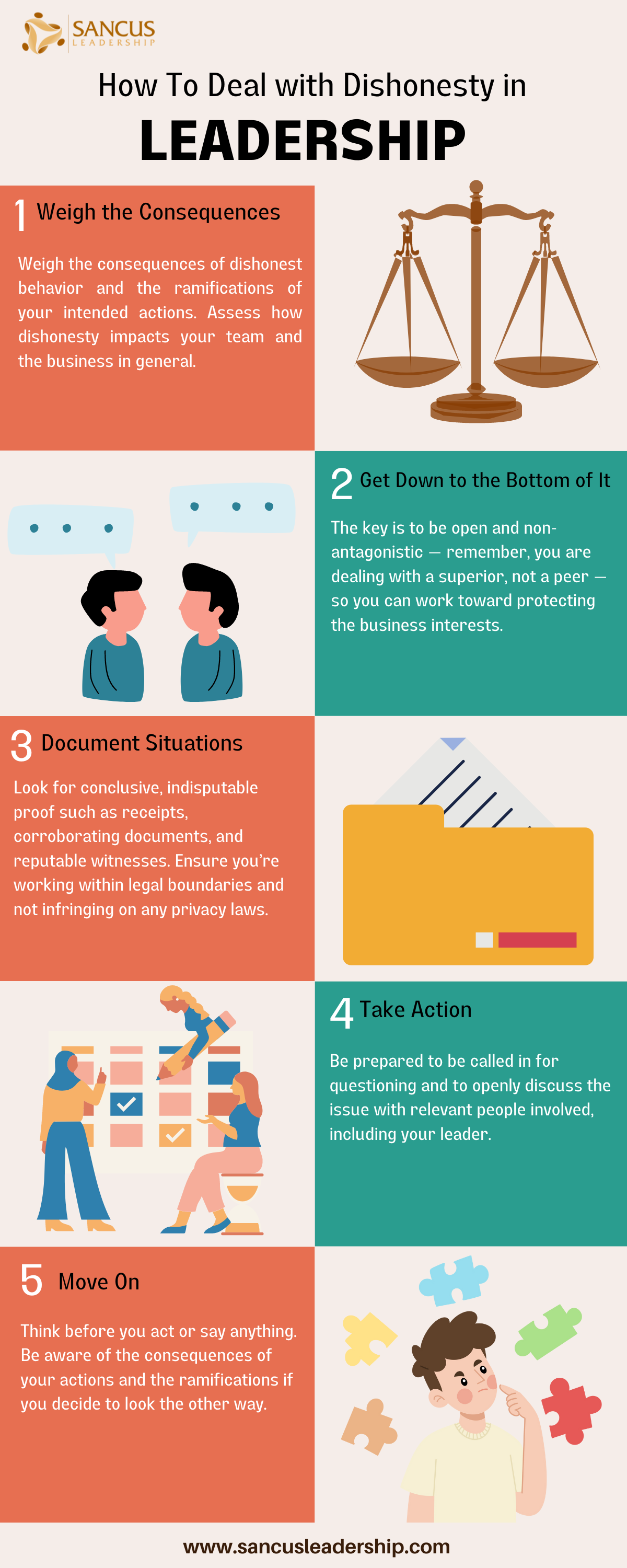What will you do when you recognize dishonesty in a leader? Like most people, will you make up excuses for the person involved and decide to look the other way simply because it is such an unfamiliar, daunting, and risky predicament? Consider this — if you don’t nip the issue in the bud, it could quickly balloon into something entirely beyond your control, something you and the team will have difficulty bouncing back from.
Deal with a dishonest leader by being transparent and constructive with your perspective. If the issue is too complex for you to handle, elevate it to HR so disciplinary actions and sanctions can be duly implemented. Arm yourself with solid evidence at all times.
Read on to find out what you can do if you come face-to-face with dishonest leadership. Learn how to be constructive and non-confrontational, especially when openly discussing the matter with the leader involved, and find out why you should gather evidence early on so you’re equipped with not just words when you bring the subject up. Let’s start!
How To Deal with Dishonesty in Leadership

When you hear the word “leader,” do you automatically envision someone worthy of admiration, someone with high integrity and moral values, therefore worthy of your complete trust and confidence?
Leaders are often put on a pedestal, which isn’t always good because this situation forges a double-edged sword. On the one hand, you’ll occasionally come across a leader who can potentially live up to all your lofty expectations. Still, on the other hand, you’ll more frequently encounter leaders with faults and limitations, just like everyone else.
So what will you do when you come face to face with a dishonest leader? Will you pretend to ignore the situation, telling yourself it’s probably just a phase, or maybe they’re going through a difficult time or just in a bad mood? Looking the other way and attempting to justify their actions can expose the business to dire consequences such as:
- Promotion of an unethical workplace culture
- Stimulation of a low-trust work environment
- Low employee satisfaction
- High employee turnover rate
- Lost business opportunities
- Financial losses for the business
- Grave legal infringements and expenses
At Sancus Leadership, we exalt the value of honesty in leadership. We encourage leaders and team members to be mindful of the signs of dishonest leadership so we can work together to arrest the situation quickly.
Dishonesty in leadership has a direct and acute impact on the team. Here are some tips on how you can effectively address such a tricky situation:

1. Weigh the Consequences
Honesty isn’t a perfect virtue. It won’t always benefit the business because, sometimes, being too truthful may put the organization at risk. When faced with a dishonest leader, weighing matters before deciding on your next steps is essential.
When faced with a dishonest leader, it’s essential to weigh matters before deciding on your next steps.
How does their dishonesty impact the team?
Are the consequences so disastrous that their misconduct merits immediate attention?
Could there be a hidden agenda behind this apparent misconduct?
Is it possible that my leader isn’t dishonest but merely covering up for something?
Weigh the consequences of dishonest behavior and the ramifications of your intended actions. Assess how dishonesty impacts your team and the business in general. Knowing the potential damage it may cause will help you develop the appropriate action plan in dealing with dishonest leadership.
2. Get Down to the Bottom of It
Honest leaders are excellent role models for their teams. They demonstrate values and behaviors worthy of emulation that promote a transparent, engaging culture in the workplace. It can be pretty jarring when a leader exhibits signs of dishonesty since they’re expected to exemplify the values they promote.
Verify the integrity of the dishonest behavior. Remember, you could also deal with rumors, blatant lies, misunderstandings, or false accusations. Once dishonesty is established, get down to the bottom of it by openly discussing the matter with your leader.
Verify the integrity of the dishonest behavior.
Be straightforward and make it a conversation, not a confrontation. Try to uncover the reasons and motives behind their dishonest behavior. Please give them the benefit of the doubt by floating the idea that you’re not confident they’re being dishonest. Discuss their actions’ consequences and how they can impact the business’s reputation and productivity.
Consider using these statements:
Please help me understand why you chose to take that route.
You may not know this, but your recent behavior has hurt the team. Can we talk about it?
Can you enlighten me on the possible effects of your decision? I’m under the impression that there are much better options available.
Be prepared for some backlash, primarily when your leader responds vehemently to your efforts. They may turn the situation around so you look like the offender. You may also be in a foot-in-the-mouth situation because you may have misread your leader’s actions completely.
The key is to be open and non-antagonistic — remember, you are dealing with a superior, not a peer — so you can work toward protecting the business interests and ensuring that dishonest behavior doesn’t thrive in the workplace.
3. Document Situations
One of the clear signs that a leader practices effective leadership is when their team starts mirroring them. Honesty is contagious, and the lack of it is, too. When you begin noticing your leaders’ actions reflecting on your team members, it indicates that the situation needs to be swiftly addressed.
Document this tricky situation by gathering as much evidence of dishonesty as possible. In most cases where leaders are involved, significantly when the case is elevated to higher venues, your word against theirs won’t be sufficient evidence that this is indeed a case of dishonesty.
Look for conclusive, indisputable proof such as receipts, corroborating documents, and reputable witnesses. Ensure you’re working within legal boundaries and not infringing on any privacy laws. Your efforts can quickly backfire if you’re not careful with obtaining irrefutable proof of dishonesty.
You can either share these pieces of evidence with your leader to hopefully help them realize the impact dishonesty has had on the team, or you can set this aside when you feel confident approaching higher management or HR about the situation.
4. Take Action
Honesty and integrity are essential values that will encourage a team to be productive, take risks, explore uncharted waters, and take ownership of their work. If a leader is dishonest, it will directly impact the team’s work culture and productivity. It may also adversely affect the team’s synergy and seamless workflow because dishonesty in leadership promotes high employee turnover. In reality, nobody likes working with someone they can’t trust.
Consider elevating the issue to higher management or HR when dishonest leadership gets out of hand. Most organizations have a clear action plan for dealing with grave issues such as dishonesty or fraud. Let them handle the situation as best they can, especially since you’re not in a position (hierarchy-wise) to reprimand your leader and impose sanctions on his misconduct.
Be prepared to be called in for questioning and to openly discuss the issue with relevant people involved, including your leader. This process can stretch on for some time, so be prepared to still work with your boss despite this sticky situation you’re both in.
5. Move On
It’s a complex situation when a superior is involved with dishonesty in the workplace. Considering their loftier position in the company hierarchy, you may feel you cannot be as reactive as you’d like. In these situations, it’s best to be as collected and constructive as possible to deal with the situation productively.
Think before you act or say anything. Be aware of the consequences of your actions and the ramifications if you decide to look the other way. If you decide to talk to your leader about the issue, convey that, like the company, you have a solid moral and ethical code you would like to live by.
Be aware of the consequences of your actions and the ramifications if you decide to look the other way.
Suppose you opt to shut your eyes to the situation. In that case, it can turn out that the dishonest behavior was just a one-time thing, perhaps a misjudgment on your leader’s part or a misdemeanor they’re feeling red-faced about now.
However, also be prepared to face the reality that your leader’s unruly, dishonest behavior can progress and may eventually promote an unethical culture in the workplace. In this case, you might want to start looking for opportunities elsewhere where you’ll feel more engaged, appreciated, and secure.
| How to deal with dishonesty in leadership | Description |
| Weigh the Consequences | Weigh the consequences of dishonest behavior and the ramifications of your intended actions. Assess how dishonesty impacts your team and the business in general. |
| Get Down to the Bottom of It | Verify the integrity of the dishonest behavior. Remember, you could also be dealing with rumors, blatant lies, misunderstandings, or false accusations. Once dishonesty is established, get down to the bottom of it by openly discussing the matter with your leader. |
| Document Situations | Document this tricky situation by gathering as much evidence of dishonesty as possible. In most cases where leaders are involved, significantly when the case is elevated to higher venues, your word against theirs won’t be sufficient evidence that this is indeed a case of dishonesty. |
| Take Action | If a leader is dishonest, it will directly impact the team’s work culture and productivity. It may also adversely affect the team’s synergy and seamless workflow because dishonesty in leadership promotes high employee turnover. |
| Move On | Think before you act or say anything. Be aware of the consequences of your actions and the ramifications if you decide to look the other way. |
Here’s an excerpt from Jocko Willink’s podcast sharing his insights and advice on how to deal with bad leaders.
Key Takeaways
Dishonesty in leadership is a complex matter to come face-to-face with. We expect leaders to consistently demonstrate the values and principles they promote, so it’s confounding when you discover dishonesty in a leader.
It’s crucial to nip the situation in the bud before it profoundly affects the business. Talk to your leader and make them aware of how their actions impact the team. Be ready with solid evidence, especially when the time comes that the matter has to be elevated to HR.
Always be constructive rather than confrontational. Remember, sometimes the best option is to look for another job.



